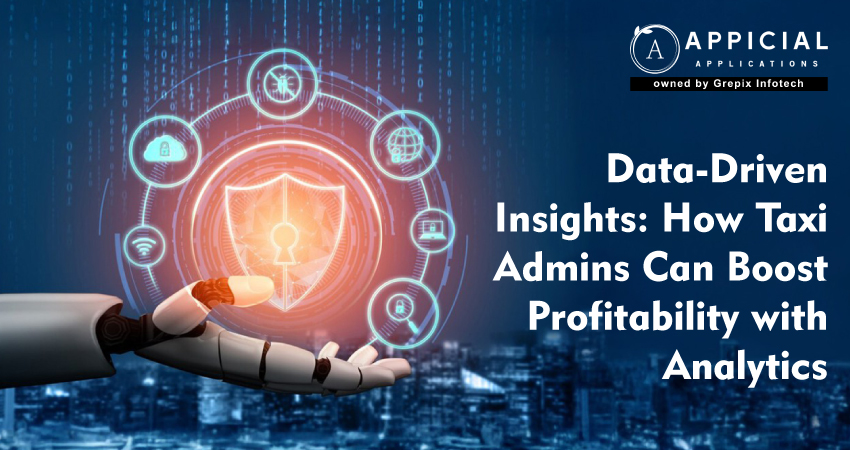
Data-Driven Insights: How Taxi Admins Can Boost Profitability with Analytics?
One truth underpins modern transportation: data does not lie. Every trip request, every driver rating and every payment log has signals about the health of the business. Taxi admins who can decipher those signals will have fatter profits, more fluid operations, and will make better decisions.
If you manage a ridesharing app or an Uber Clone, this is not a nice-to-have. It’s essential. The modern mobility industry moves fast, and data-driven platforms dominate it. A business that collects data but fails to analyse it risks losing ground. On the other hand, a taxi company equipped with an advanced white-label taxi booking app built by a capable taxi app development company gains access to performance insights in real time.
Analytics gives structure to complex data. It reveals which drivers perform best, when demand surges, and where fuel costs rise. According to a 2024 global market study, data-driven transportation companies outperform competitors by up to 25% in profit margin. That’s no coincidence, it’s a direct result of smart analytics integration.
Taxi admins can dramatically boost profitability and operational efficiency by leveraging advanced analytics in their Uber Clone or ride-sharing app powered by a white-label solution. Real-time dashboards present actionable insights—such as driver utilization, trip completion rates, and demand mapping allowing admins to optimize routes, fares, and fleet management. Predictive analytics and AI automate decisions in pricing, fraud detection, and cost control. As market studies show, data driven taxi companies outperform competitors by up to 25% in profit margin. Modern taxi booking apps from trusted development companies make analytics accessible for both large and small fleets, ensuring secure, scalable, and informed business growth for long-term success.
What analytics metrics matter most for taxi admins?
Analytics turns chaos into clarity. Taxi admins managing an Uber Clone or ride-sharing app should rely on specific metrics that define success. The goal isn’t to track everything, it’s to track what matters.
Here are the most essential metrics for operational efficiency and profitability:
- Revenue per trip: Helps you understand how much income each completed ride contributes after costs and whether fare strategies are working.
- Driver utilisation rate: Identifies underutilised drivers and helps rebalance schedules to maximise active hours.
- Trip completion ratio: Compares successful rides against total bookings to diagnose cancellation or dispatch problems.
- Average trip duration and distance: Reveals routing efficiency and assists in zoning and fare optimisation.
- Customer acquisition and retention cost: Links marketing spending to rider activity to evaluate campaign ROI.
- Cancellation rate and reasons: Highlights why customers cancel, enabling fixes that improve conversion and satisfaction.
- Peak demand mapping: Uses heatmaps to plan surge pricing, driver positioning, and operational readiness.
A white-label taxi booking app designed by a professional taxi app development company provides all these metrics through live dashboards. Instead of spreadsheets and manual reports, admins get real-time visual feedback to make faster, smarter adjustments.
How does analytics improve pricing and revenue optimisation?
Revenue management is the backbone of a successful ride-sharing app. Without data, pricing becomes guesswork. Analytics eliminates that uncertainty by linking pricing models directly to rider behaviour, demand cycles, and operational costs.
- Demand-based pricing: Machine learning monitors booking patterns to trigger dynamic pricing during high-demand periods.
- Geographical pricing zones: Data reveals price sensitivity across regions, allowing region-specific fare adjustments.
- Discount performance analysis: Tracks whether promotional campaigns lead to repeat usage and retention.
- Cost-per-trip analysis: Integrates fuel, maintenance, and commissions to find minimum profitable pricing points.
- Driver incentive tracking: Evaluates whether incentives improve performance or inflate payouts unnecessarily.
An advanced white-label taxi booking app built by an experienced taxi app development company combines financial data, trip logs, and demand trends to guide profitable pricing strategies.
How can analytics strengthen fleet and driver management?
Fleet and driver management generate the majority of operational data in an Uber Clone or ride-sharing app. Analytics turns that data into practical action.
- Driver performance: Tracks acceptance rates, ratings, punctuality, and engagement to identify coaching and reward needs.
- Route optimisation: Uses traffic and GPS data to suggest efficient routing that increases trip volume and reduces fuel costs.
- Maintenance analytics: Predicts vehicle wear and service timelines to prevent breakdowns.
- Driver engagement insights: Shows patterns in driver workflow and earnings to improve scheduling and motivation.
- Idle fleet management: Flags underutilised vehicles so they can be reassigned to high-demand zones.
A professional white label taxi app development company integrates all of this into the admin dashboard so operators don’t need third-party tools.
How does analytics reduce operational costs?
Fuel, maintenance, and customer acquisition costs rise quickly. Analytics identifies waste and reduces it without compromising service quality.
- Smart dispatching: Assigns drivers closest to riders to reduce idle mileage.
- Fuel tracking: Uses trip and route analytics to highlight inefficiencies that inflate fuel usage.
- Maintenance forecasting: Predicts failures and schedules preventive care to avoid costly repairs.
- Expense benchmarking: Compares driver/vehicle performance to identify cost-heavy assets.
- Fraud detection: Flags unusual booking/payment behavior patterns.
- Customer churn control: Identifies inactive users to trigger re-engagement campaigns.
The right taxi app development company builds analytics frameworks that automate cost control and make savings measurable.
What technology powers analytics in taxi applications?
- Data ingestion systems: Capture real-time trip, location, payment, and user data.
- Data warehouse and cloud architecture: Stores and manages large-scale datasets securely and efficiently.
- ETL pipelines: Clean and standardise data for accurate reporting.
- Predictive analytics: Uses machine learning to forecast demand, downtime, and churn.
- Visual analytics dashboards: Converts raw data into understandable charts for non-technical admins.
- Security and compliance modules: Encrypt and protect sensitive user data.
A taxi app development company specialising in scalable data solutions builds these systems to support millions of transactions while maintaining analysis speed.
Learn More: How Smart Dashboards Simplify Fleet and Driver Management
Why analytics is crucial for scalability and long-term profitability?
- Scalable decision-making: Identifies profitable regions and expansion timing.
- Market adaptation: Tracks behavioural shifts to adjust services before trends change.
- Operational forecasts: Predicts future fleet, driver, and financial needs.
- Resource planning: Guides vehicle acquisition and app feature investment.
- Stakeholder reporting: Transparent performance data supports investor confidence.
Analytics makes scaling systematic rather than risky, especially when embedded in a white-label taxi booking app.
The link between AI, analytics, and performance automation
- AI route optimisation: Automatically reroutes drivers to cut travel time.
- Demand forecasting: Predicts surges using historical and environmental data.
- Driver behaviour monitoring: Detects unsafe driving using sensor and telematics analysis.
- Customer sentiment analysis: NLP evaluates feedback trends in real time.
- Automated fraud detection: AI identifies patterns of coordinated misuse.
An advanced taxi app development company integrates analytics and AI so the system not only shows insights but acts on them.
Conclusion
Profitability in the ride-hailing industry comes from control. Analytics lets admins see cost leaks, opportunities, and fleet performance clearly. Whether adjusting fares, preventing fraud, or planning growth, analytics enables strategic decision-making instead of guesswork.
Appicial Applications leads the industry with analytics-ready white-label taxi booking app solutions. Their platforms include predictive dashboards, fleet insights, performance monitoring, and admin control systems.
Looking to make data your competitive advantage? Contact Appicial Applications today and transform analytics into measurable growth.
FAQs
Author's Bio

Vinay Jain is the Founder at Grepix Infotech and brings over 12 years of entrepreneurial experience. His focus revolves around software & business development and customer satisfaction.
Back to blog list




